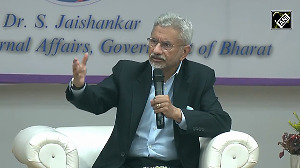The debate on whether economic reforms and accelerated economic growth have led to faster reduction in poverty levels and employment growth continues to generate disagreement.
Settling these big questions is important, because an economy that is accelerating further to 9 per cent annual growth has to ask itself whether it needs programmes like the National Rural Employment Guarantee Scheme, whether the pattern of growth is "inclusive" enough, and whether the money would be better spent in improving health and education levels (among all the other choices available).
Those cheering the reform programme and its results have got a shot in the arm because of the findings of the National Sample Survey's 2004-05 large-sample round, which came out earlier this month.
Till then, the criticism had been that India was experiencing jobless growth. The small-sample, or thin rounds, of the NSS each year had already been suggesting that employment growth was picking up, but the critics dismissed these as being unrepresentative.
In the event, the figure cited most often said that employment in the country grew by only 1 per cent per annum between 1993-94 and 1999-00, barely half that of previous decades and little more than half the rate of population growth.
This belief provided the under-pinning for the United Progressive Alliance's rural employment guarantee scheme. However, the latest NSS data now suggest that employment growth between 1993-94 and 2004-05 grew at an annual rate of 2.1 per cent.
This is not only (marginally) higher than that in the past, it is also faster than the population growth rate, and so it knocks the statistical bottom out of the jobless growth theory. In short, it has to be accepted now that the post-reform period has been slightly better for employment growth.
What of the larger poverty question? While the NSS estimated the percentage of people living below the poverty line in 1993-94 at 37 per cent, the latest data place this at 22 or 28 per cent in 2004-05 (the two numbers are derived from two ways of asking the question!).
That is, poverty in India has fallen by between 0.8 and 1.3 percentage points per year. At that rate, it will take up to two decades and more to eradicate absolute poverty - a scenario that most people will rightly find unacceptable.
What complicates the debate is that the measurement of consumption, and therefore poverty, is fatally flawed. The optimists use the data in one way to argue that poverty levels are much less than the official figures aver; right or wrong, this is not the mainstream view, which is that rapid economic growth has not been accompanied by a fast enough decline in poverty levels.
It is important to go beyond the economists' debate and focus on the kind of issues highlighted in the latest Human Development Report. Sanitation levels in India are among the worst in the world, and account for a substantial part of the health problem.
Clean water supply is another scarce commodity. The standards of health and literacy are nothing to write home about, and governance standards in the key states have fallen to levels where the government's programmes suffer from both poor effectiveness and extensive leakages.
These issues need to be addressed because they affect the poor the most, and they are therefore more important for poverty removal than abstract debates about statistical methodology, patterns of development and inclusiveness.
The challenges of development and poverty removal lie more in the area of devising effective delivery models and less in arcane debates about the changing patterns of demand and supply.







 © 2025
© 2025